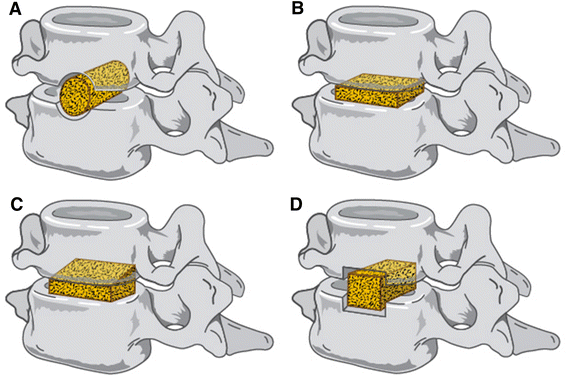The design evolution of interbody cages in anterior cervical discectomy and fusion: a systematic review
- PMID: 25907826
- PMCID: PMC4416390
- DOI: 10.1186/s12891-015-0546-x
The design evolution of interbody cages in anterior cervical discectomy and fusion: a systematic review
Abstract
Background: Anterior cervical discectomy with fusion is a common surgical procedure for patients experiencing pain and/or neurological deficits due to cervical spondylosis. Although iliac crest bone graft remains the gold standard today, the associated morbidity has inspired the search for alternatives, including allograft, synthetic and factor/cell-based grafts; and has further led to a focus on cage fusion technology. Compared to their graft counterparts, cage interbody implants have enhanced biomechanical properties, with designs constantly improving to maximise biocompatibility and osseointegration. We present a systematic review examining the historical progress of implant designs and performance, as well as an update on the currently available designs, and the potential future of cervical interbody implants.
Methods: We performed a systematic review using the keywords "cervical fusion implant design", with no limits on year of publication. Databases used were PubMed, Medline, Embase and Cochrane. In addition, the search was extended to the reference lists of selected articles.
Results: 180 articles were reviewed and 64 articles were eligible for inclusion. Exclusion criteria were based around study design, implant information and patient cohorts. The evolution of cage implant design has been shaped by improved understanding of ideal anatomy, progress in materials research and continuing experimentation of structural design. Originally, designs varied primarily in their choice of structure, however long-term studies have displayed the overall advantages of non-threaded, wedge shaped cages in complementing healthy anatomical profiles, and thus focus has shifted to refining material utilisation and streamlining anterior fixation.
Conclusions: Evolution of design has been dramatic over the past decades; however an ideal cage design has yet to be realised. Current research is focusing on the promotion of osseointegration through bioactiviation of surface materials, as well as streamlining anterior fixation with the introduction of integrated screws and zero profile designs. Future designs will benefit from a combination of these advances in order to achieve ideal disc heights, cervical alignments and fusions.
Figures





References
Publication types
MeSH terms
LinkOut - more resources
Full Text Sources
Other Literature Sources
Medical
Miscellaneous

